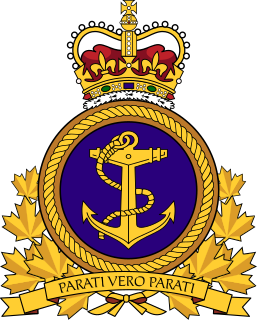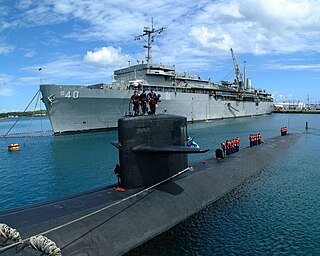See also
- HMS Rainbow, nine ships of the Royal Navy, including the first HMCS Rainbow
- USS Rainbow (AS-7), a distilling ship and submarine tender of the United States Navy
Two vessels of the Royal Canadian Navy have been named HMCS Rainbow, after the rainbow.
The name USS Argonaut may refer to the following submarines of the United States Navy:

The Royal Canadian Navy is the naval force of Canada. The RCN is one of three environmental commands within the Canadian Armed Forces. As of 2021[update], the RCN operates 12 frigates, four attack submarines, 12 coastal defence vessels, eight patrol class training vessels, one offshore patrol vessel, and several auxiliary vessels. The RCN consists of 8,300 Regular Force and 3,600 Primary Reserve sailors, supported by 3,800 civilians. Vice-Admiral Craig Baines is the current commander of the Royal Canadian Navy and chief of the Naval Staff.

USS Argonaut (SS-475) was a Tench-class submarine operated by the United States Navy (USN). Constructed at Portsmouth Navy Yard during the second half of 1944, Argonaut was commissioned into the USN in 1945 and operated during the final year of World War II, although her only contact with the Japanese was when she sank a junk in August. During the 1950s, the submarine was modified for greater underwater endurance, and to guide the Regulus I missile. From 1963 to 1965, Argonaut operated in the Mediterranean Sea.

A light aircraft carrier, or light fleet carrier, is an aircraft carrier that is smaller than the standard carriers of a navy. The precise definition of the type varies by country; light carriers typically have a complement of aircraft only one-half to two-thirds the size of a full-sized fleet carrier. A light carrier was similar in concept to an escort carrier in most respects, however light carriers were intended for higher speeds to be deployed alongside fleet carriers, while escort carriers usually defended convoys and provided air support during amphibious operations.

A submarine tender is a type of depot ship that supplies and supports submarines.

USS Crowninshield (DD–134) was a Wickes-class destroyer in the United States Navy between World War I and World War II. She was named for Benjamin Williams Crowninshield. In World War II she was transferred to the Royal Navy where she was named HMS Chelsea, and subsequently to the Soviet Navy where she was named Derzky.

USS Maddox (DD–168) was a Wickes-class destroyer in the United States Navy during World War I. She was later transferred to the Royal Navy as HMS Georgetown (I-40), to the Royal Canadian Navy as HMCS Georgetown, and then to the Soviet Navy as Doblestny . She was the last "four piper" destroyer to be scrapped.

USS Burrfish (SS/SSR-312) was a Balao-class submarine of the United States Navy named for the burrfish, a swellfish of the Atlantic coast. The vessel entered service in 1943 and saw action during World War II and in the postwar era. In 1961 Burrfish was loaned to the Royal Canadian Navy where she served as HMCS Grilse and was used primarily as a training boat from 1961 until 1969.

The first USS Kalk (DD–170) was a Wickes-class destroyer in the United States Navy during World War I, later transferred to the Royal Navy as HMS Hamilton (I24) and then into the Royal Canadian Navy as HMCS Hamilton (I24).
Seven ships of the Royal Navy have been named HMS Queen. It is one of the oldest ship names of the Royal Navy dating from the time of Henry III of England.
Two ships of the United States Navy have borne the name USS Yarnall, in honor of Lieutenant John Yarnall (1786–1815).

HMCS Ontario can refer to several ships:
The name HMS Churchill has been borne by two ships of the Royal Navy; a destroyer and a submarine. The submarine is named for Winston Churchill, Prime Minister of the United Kingdom during World War II; the destroyer for towns of that name common to the United States and Britain.
Several Canadian naval units have been named HMCS Quebec.
Nine ships of the Royal Navy have been named HMS Rainbow, after the rainbow, a common meteorological phenomenon:
Poseidon has been the name of a number of ships, both real and in fiction.
The following index is provided as an overview of and topical guide to Wikipedia's articles on recreational dive sites. The level of coverage may vary:

Recreational dive sites are specific places that recreational scuba divers go to enjoy the underwater environment or for training purposes. They include technical diving sites beyond the range generally accepted for recreational diving. In this context all diving done for recreational purposes is included. Professional diving tends to be done where the job is, and with the exception of diver training and leading groups of recreational divers, does not generally occur at specific sites chosen for their easy access, pleasant conditions or interesting features.